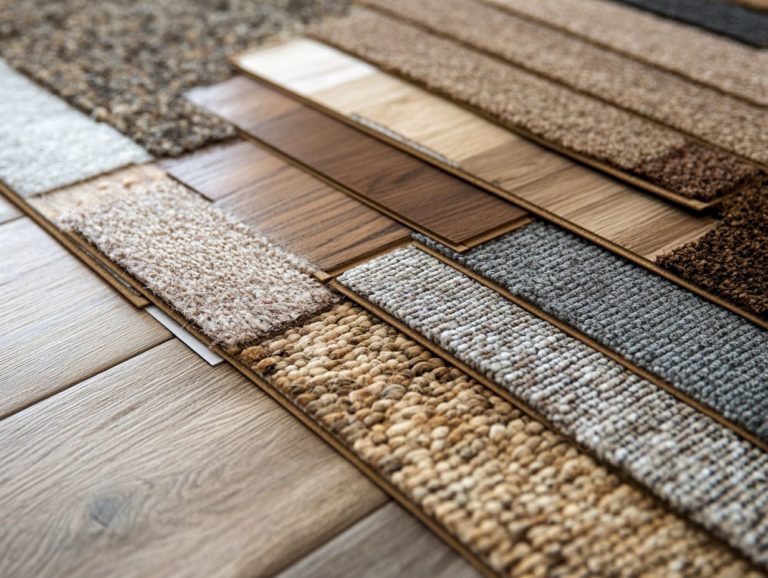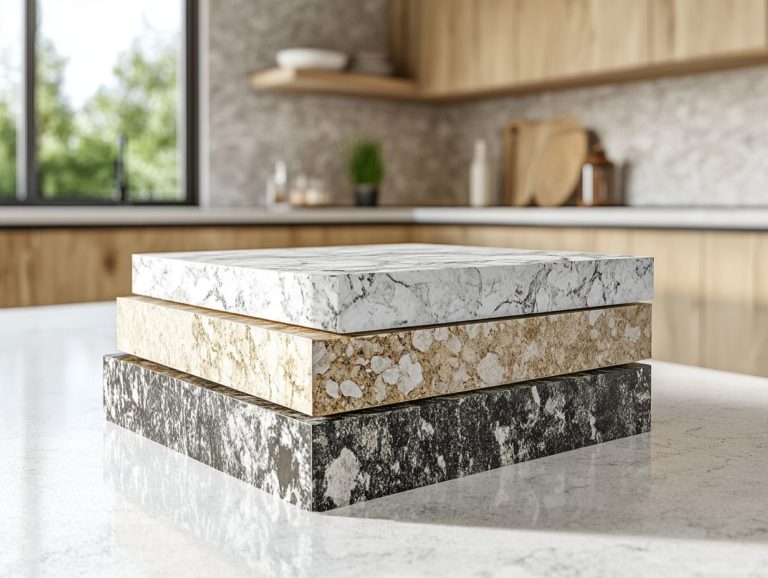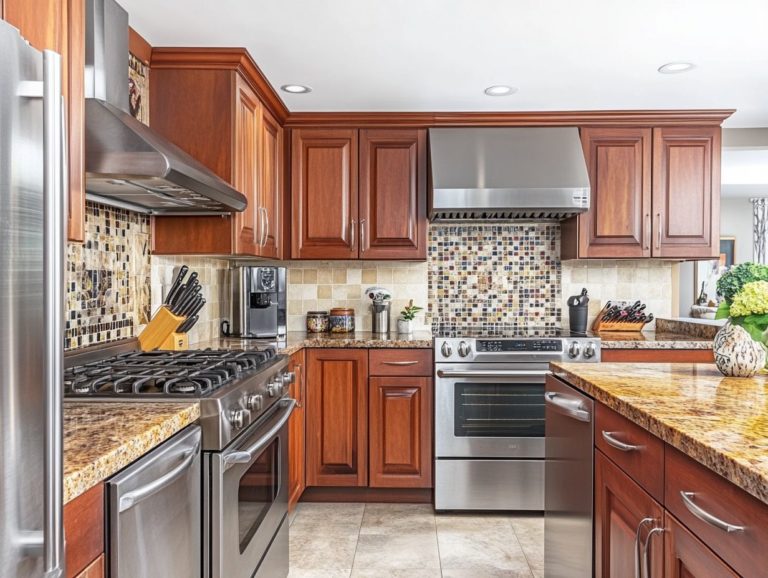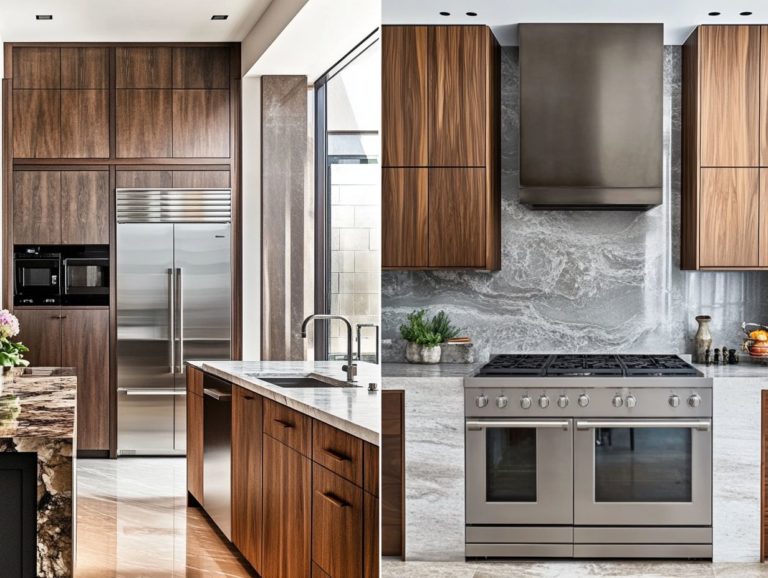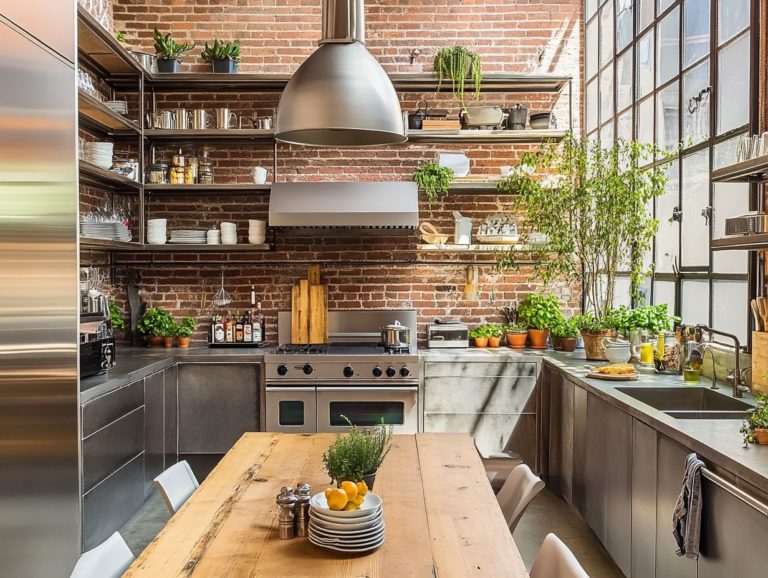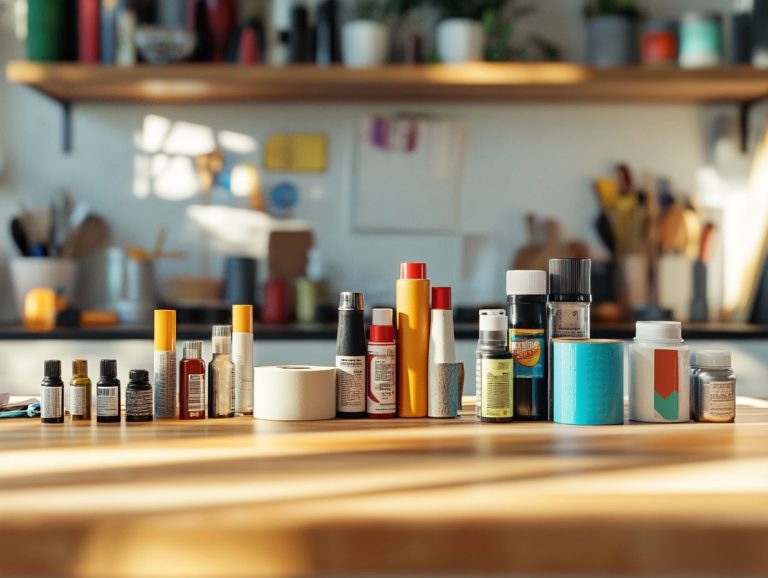5 Popular Materials for Custom Kitchen Islands
Choosing the right material for your custom kitchen island can truly transform both functionality and style. With choices that span from the timeless allure of wood to the sleek sophistication of stainless steel, each material brings its own set of advantages and disadvantages.
This article delves into five popular materials—wood, marble, stainless steel, concrete, and quartz—showcasing their pros and cons, maintenance requirements, and aesthetic contributions.
Whether you seek durability for a bustling kitchen or a cost-effective solution, you’ll discover valuable insights tailored just for you!
Contents
- Key Takeaways:
- 1. Wood
- 2. Marble
- 3. Stainless Steel
- 4. Concrete
- 5. Quartz
- How to Choose the Right Material for Your Custom Kitchen Island?
- What Is the Best Material for a High-Traffic Kitchen?
- How Do These Materials Affect the Overall Aesthetic of the Kitchen?
- What Is the Maintenance and Durability of Each Material?
- Which Material Is the Most Cost-Effective for a Kitchen Island?
- Frequently Asked Questions
- What are the top 5 popular materials for custom kitchen islands?
- Can I use any of these materials for my kitchen island?
- What are the benefits of using granite for a custom kitchen island?
- Is wood a practical choice for a kitchen island?
- What makes stainless steel a good option for a custom kitchen island?
- Why would someone choose marble as the material for their kitchen island?
Key Takeaways:
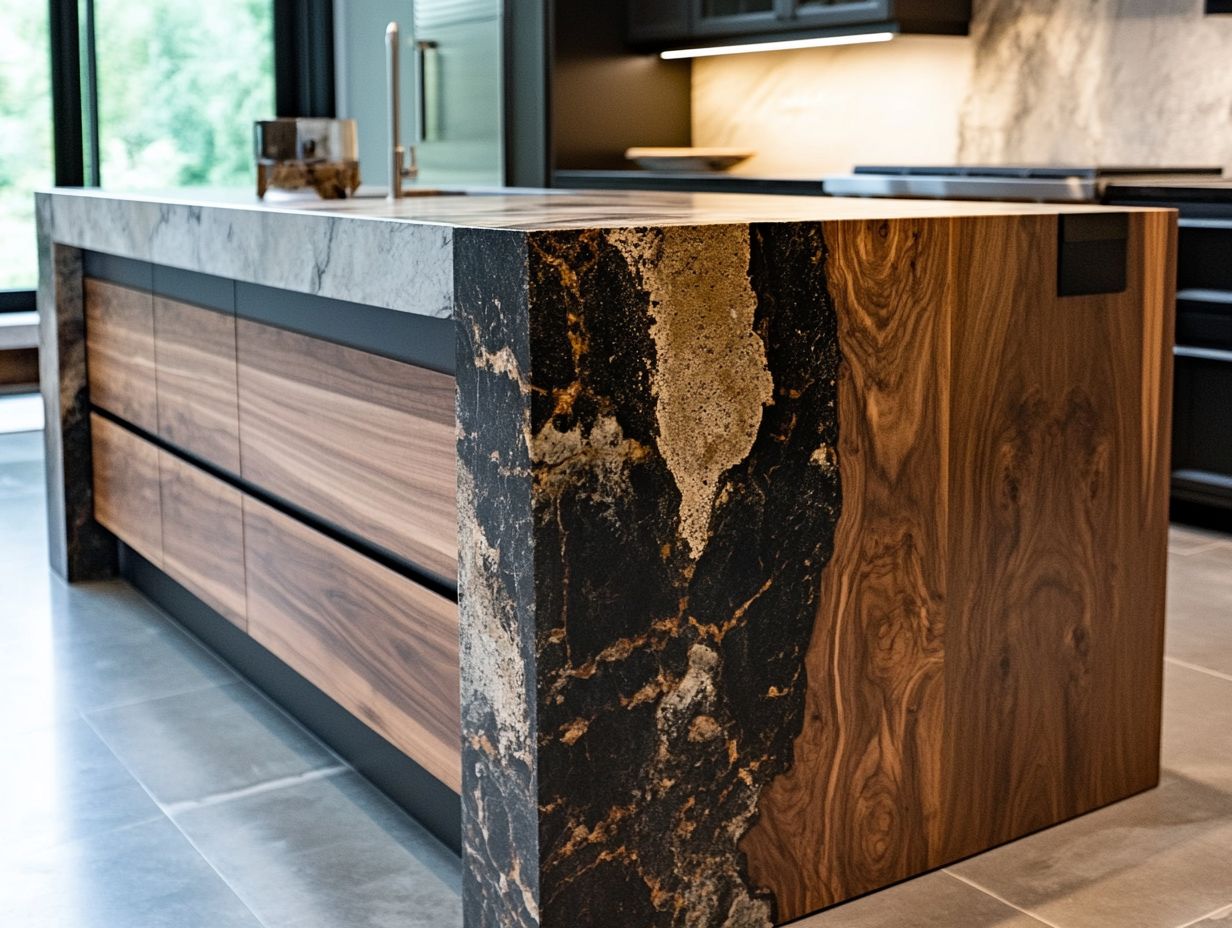
- Wood is a timeless and versatile material for custom kitchen islands, offering warmth and character. However, it requires regular maintenance and is not as durable as other options.
- Marble adds a luxurious touch to any kitchen island, but it can be prone to scratches and stains. It is also one of the more expensive options.
- Stainless steel is durable, easy to clean, and offers a modern and sleek look. It is a great choice for high-traffic kitchens, but it may not suit all aesthetics.
1. Wood
Wood stands as a timeless choice for your kitchen island, bringing a warm and inviting aesthetic that effortlessly blends with various designs. Whether your style leans toward rustic charm or modern elegance, wood can adapt beautifully.
Beyond its beauty, wood offers remarkable durability and functionality. It transforms your cooking prep and workspace into a delightful experience.
Its versatility allows you to explore an array of styles, from the rich, deep hues of walnut to the light, airy tones of maple. Each enhances the overall dynamics of your kitchen.
The unique grains and textures of different wood types infuse character into your island. They harmonize beautifully with your cabinetry and countertops.
Wood also offers practical solutions like customizable storage options, such as shelves or drawers tailored to your specific needs. With care, your wood kitchen island can become a stunning centerpiece that you’ll love for years!
Which material speaks to you for your kitchen island?
2. Marble
Marble countertops embody luxury and elegance, making them the ideal choice for kitchen islands. They not only enhance your kitchen’s aesthetics but also create a stunning contrast with other materials.
With their unique lines and colors, this natural stone adds a custom touch to your culinary space. Its exceptional heat resistance means you can place hot pots and pans on it without worrying about damage—an advantageous feature for passionate home cooks like yourself.
Marble integrates seamlessly with a variety of kitchen styles, whether contemporary or vintage. It enhances both modern designs and rustic charm.
To keep its exquisite appearance intact, regular sealing is advisable, along with gentle cleaning products that maintain its surface without risking scratches or dullness.
Don’t miss out on the chance to elevate your kitchen with this stunning material!
3. Stainless Steel
Incorporating stainless steel into your kitchen island design offers unmatched durability and a sleek, modern aesthetic. It’s perfect for high-traffic areas while maximizing functionality and appliance storage.
This material isn’t just resistant to stains and scratches; it also easily withstands high temperatures. It ensures it stands the test of time in your bustling kitchen.
The reflective surface of stainless steel enhances natural light, brightening the overall ambiance and creating a sense of openness that you’ll truly appreciate.
It seamlessly pairs with a variety of design elements, allowing you to blend it with wood, tile, or stone for a contemporary look that suits your style.
Features like built-in sinks, cooktops, and innovative storage solutions further elevate your kitchen’s dynamics. They enhance both functionality and style without sacrificing practicality.
Which material will you choose to redefine your kitchen space?
4. Concrete
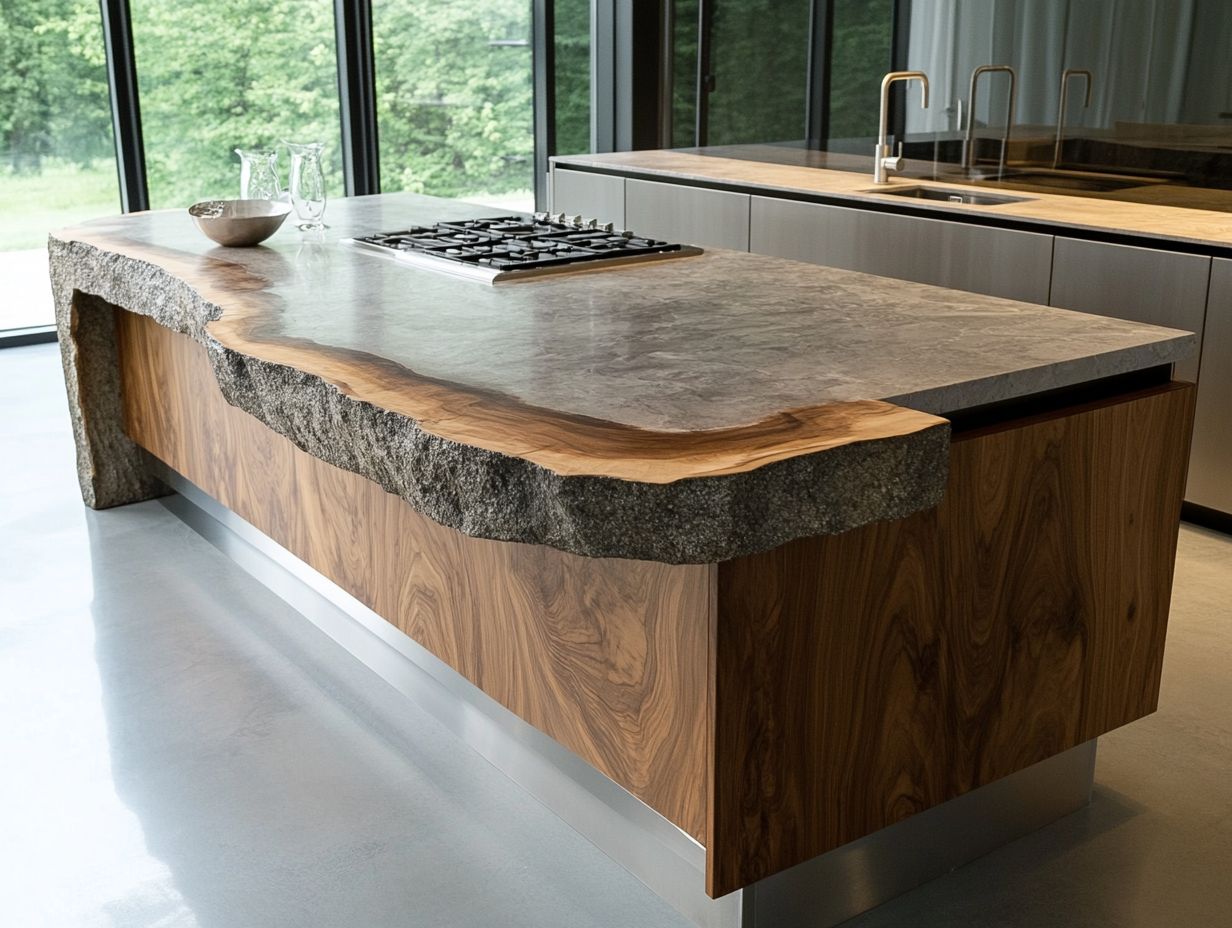
Concrete countertops blend unique design with durability. They fit perfectly in modern spaces and come in various colors.
Their versatility gives you the power to explore a wide range of finishes, textures, and colors. This ensures you find the ideal match for your decor.
A sleek polished concrete surface can evoke a minimalist vibe. In contrast, a textured, rough finish can infuse a touch of rustic charm.
Designers increasingly add embedded materials like glass or metal, crafting striking patterns that beautifully catch the light.
You can also mold concrete into various shapes, allowing for unique features like integrated sinks or custom edges. This elevates both functionality and style.
Imagine turning your kitchen island into the stunning focal point of your home!
5. Quartz
Quartz countertops stand out as a premier choice for kitchen islands. They seamlessly blend the allure of natural stone with the resilience of engineered surfaces. This combination enhances durability and offers a plethora of design inspirations for luxury kitchens.
One standout feature of quartz is its non-porous nature. This means it does not absorb liquids, making it less likely to stain. This makes it an ideal option for your bustling kitchen.
Unlike materials like granite or marble, which often necessitate sealing, quartz surfaces require minimal maintenance. This allows you to relish the beauty of your countertops without the burden of extensive upkeep.
Quartz effortlessly adapts to various kitchen aesthetics. Whether you’re leaning toward a sleek modern look or a classic rustic vibe, it remains an exceptionally versatile choice. Its durability boosts functionality while ensuring your investment endures, lending an elegant touch to your culinary space.
How to Choose the Right Material for Your Custom Kitchen Island?
Choosing the right material for your custom kitchen island requires a thoughtful approach. Consider factors like kitchen functionality, space availability, and current trends.
Ensure your choice aligns seamlessly with your overall design inspiration and lifestyle needs during your kitchen remodel. When selecting countertop materials, think carefully about style, durability, and maintenance, as these elements significantly impact your daily use.
Wood can bring warmth and a unique aesthetic to your space, but it often requires regular sealing to fend off moisture. Conversely, quartz offers an appealing combination of durability and low maintenance, perfect for busy households.
Meanwhile, marble, celebrated for its timeless elegance, may not be the best fit for high-traffic areas due to its susceptibility to staining. Understand these attributes to make informed decisions that cater to your kitchen dynamics and personal preferences.
What Are the Pros and Cons of Each Material?
Understanding the pros and cons of various countertop materials is crucial as you navigate the selection process for your kitchen island. Each material presents unique benefits and challenges regarding aesthetics, durability, and maintenance.
Take wood countertops, for example. They exude a warm, inviting charm but demand regular sealing and are vulnerable to scratches and water damage.
Then there’s marble, which, with its timeless elegance and stunning veining, can be a showstopper; however, it’s prone to staining and etching from acidic substances.
Stainless steel offers a modern, sleek appearance and impressive durability, yet it has a tendency to dent and can easily showcase fingerprints.
Concrete brings a trendy industrial vibe and customizable designs, but be cautious, as it can be heavy and susceptible to cracking if not properly sealed.
Lastly, quartz is a favorite for its resilience and low maintenance; it comes in a myriad of colors but might be less heat resistant than other options.
Each choice you make molds the overall vibe and functionality of your kitchen, significantly affecting your daily culinary experiences.
What Is the Best Material for a High-Traffic Kitchen?
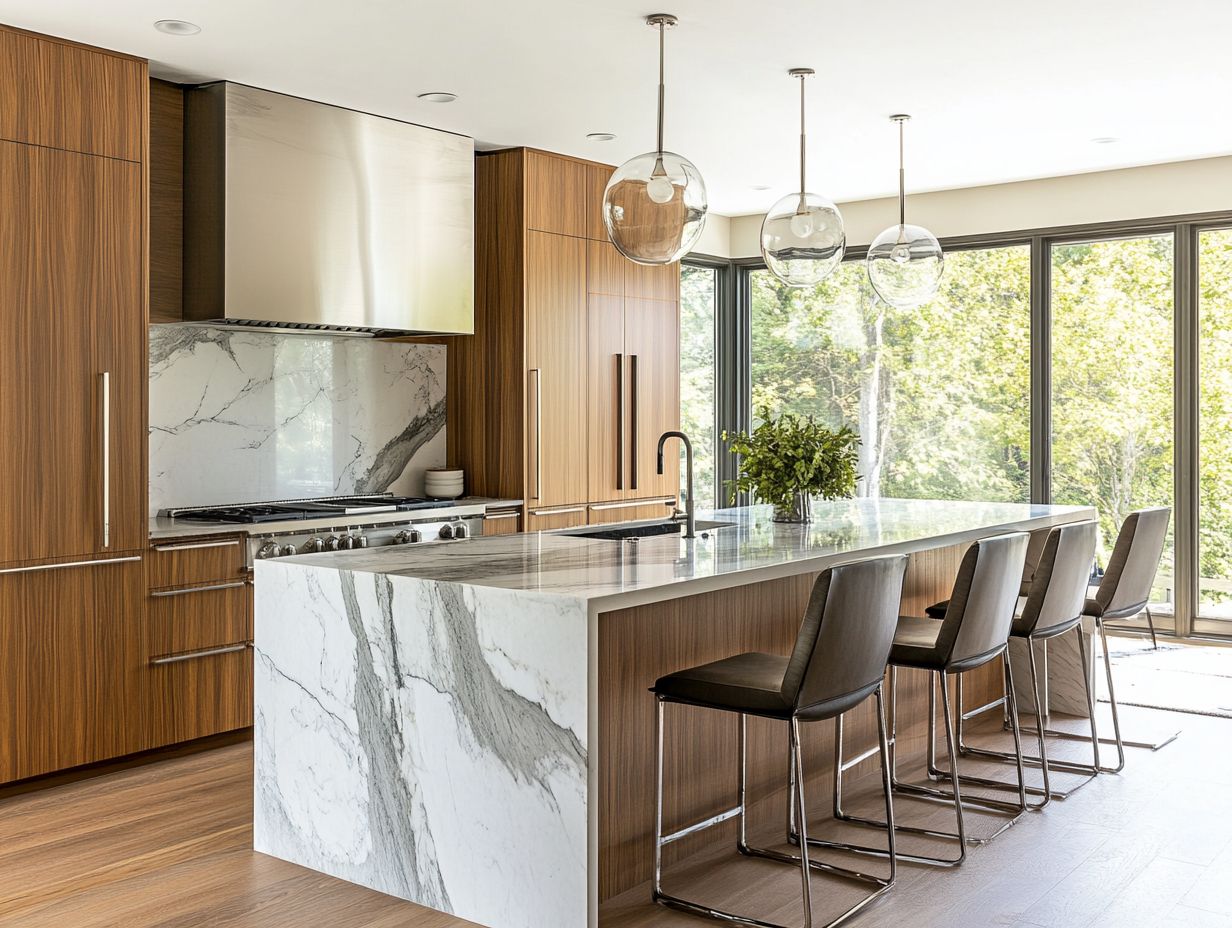
In a high-traffic kitchen, choosing a durable material for your kitchen island is essential. It must endure daily wear and tear while still looking fabulous and functioning effectively.
This choice influences your kitchen’s visual appeal and affects how easy it is for you to maintain over time. Among your best options, quartz shines brightly due to its surface that doesn’t absorb liquids, which resists stains and makes cleanup effortless.
Alternatively, stainless steel delivers a sleek, modern aesthetic and stands up remarkably well to heat and scratches. You’ll love how both materials stand the test of time! Your choice may hinge on your preferred style and daily use.
If you want something easy to maintain, quartz could be your perfect match. Conversely, if you lean towards a contemporary, industrial feel, stainless steel might just steal your heart.
How Do These Materials Affect the Overall Aesthetic of the Kitchen?
The choice of countertop materials profoundly influences the overall aesthetic of your kitchen, impacting both design appeal and color palette. This choice ultimately shapes the ambiance of the space.
Materials like quartz, granite, and wood can create a distinct atmosphere that complements your cabinets and flooring perfectly. For example, a sleek, polished marble countertop can exude luxury, especially when paired with dark cabinetry and warm wooden flooring.
Conversely, a rustic butcher block can infuse warmth and charm, providing a stunning contrast against modern, minimalist fixtures.
To achieve a cohesive look, consider harmonizing textures and colors. Opt for complementary shades that allow the materials to interact seamlessly while ensuring each component has its moment in the spotlight.
What Is the Maintenance and Durability of Each Material?
Evaluating maintenance and durability of countertop materials is crucial when selecting your kitchen island. This directly impacts how well the surface will perform in daily use and the effort needed to keep it looking immaculate.
Each material comes with its own cleaning routine and long-term implications that can significantly sway your decision. For instance, granite countertops require regular sealing to fend off stains, while quartz typically offers straightforward upkeep thanks to its non-porous nature.
Additionally, while wood finishes can elevate the aesthetic appeal, they often demand extra care to prevent scratches and water damage. Durability is another key consideration; materials like laminate may be more prone to wear and tear, while tougher options like natural stone stand strong against both scratches and stains.
By grasping these nuances, you can make a thoughtful decision that aligns perfectly with your lifestyle and aesthetic preferences.
Which Material Is the Most Cost-Effective for a Kitchen Island?
When you’re considering a kitchen island for your renovations, understanding which material is the most cost-effective is essential for balancing your budget with the quality and aesthetics you desire.
This decision goes beyond just the initial purchase price; it requires a closer look at how each countertop material will perform over time. Factors like durability, maintenance needs, and potential for damage significantly impact long-term costs.
For example, while granite might have a higher upfront price, its resilience against wear and tear can make it a smart investment compared to cheaper options that may need frequent replacements or repairs.
By carefully evaluating these elements, you can discover a solution that fits your initial budget and aligns seamlessly with your long-term kitchen aspirations.
Frequently Asked Questions
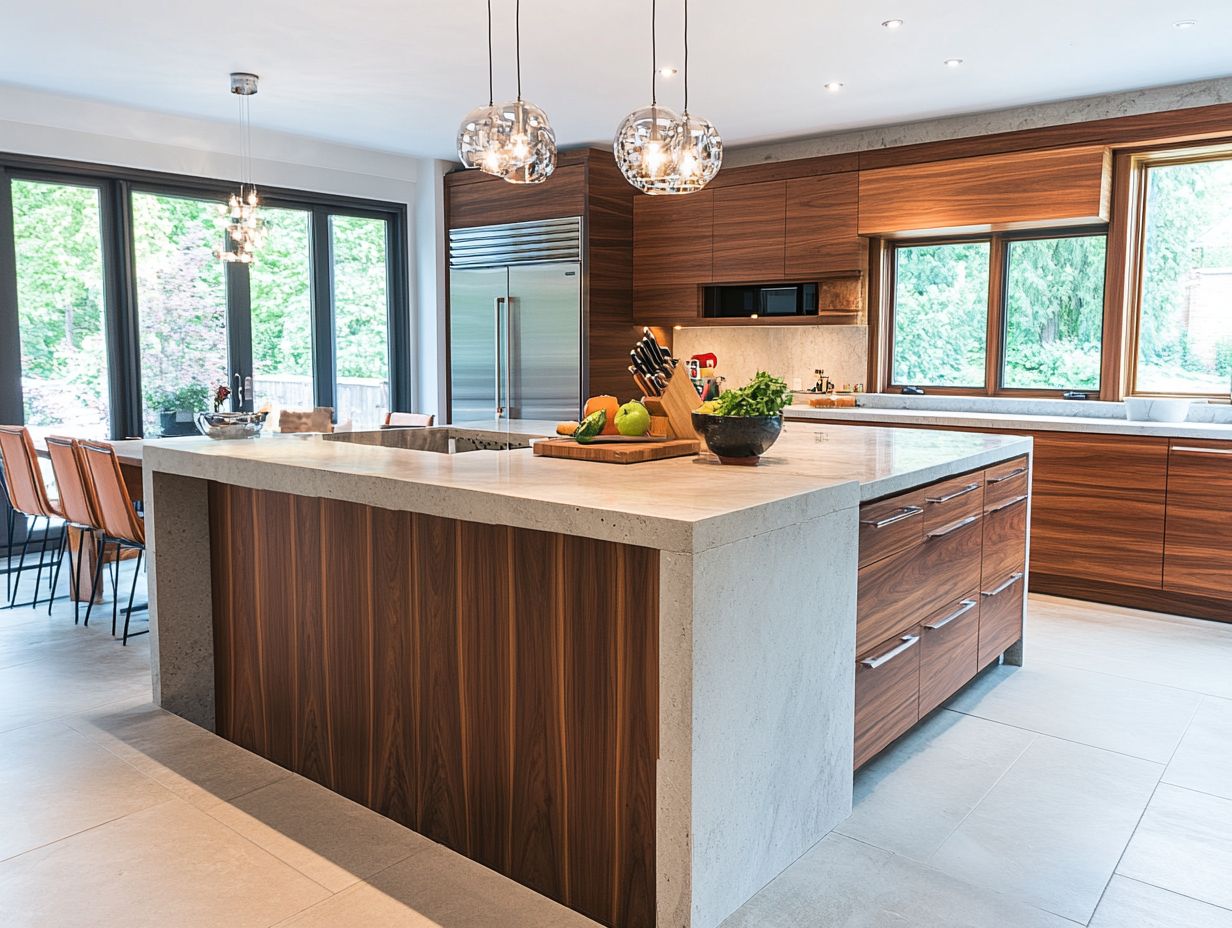
Here are some common questions about kitchen island materials:
What are the top 5 popular materials for custom kitchen islands?
The top 5 popular materials for custom kitchen islands are granite, wood, stainless steel, marble, and quartz. These materials are durable, stylish, and versatile, making them ideal for any kitchen design.
Can I use any of these materials for my kitchen island?
Yes! You can choose from five popular materials for your kitchen island. Your choice depends on your preferences, budget, and kitchen design.
What are the benefits of using granite for a custom kitchen island?
Granite is a favorite among homeowners for its stunning look and durability. It’s heat-resistant, easy to maintain, and available in various colors and patterns to match any style.
Is wood a practical choice for a kitchen island?
Wood brings warmth and character to your kitchen. Though it requires more maintenance, it’s durable and can be stained or painted to fit your decor.
What makes stainless steel a good option for a custom kitchen island?
Stainless steel offers a modern and sleek look, perfect for industrial-style kitchens. It’s durable, easy to clean, and resistant to heat and stains, giving your kitchen a high-end feel.
Why would someone choose marble as the material for their kitchen island?
Marble adds luxury and sophistication to your kitchen. It’s heat-resistant and durable for food prep, but keep in mind it requires more maintenance and is often pricier than other materials.
